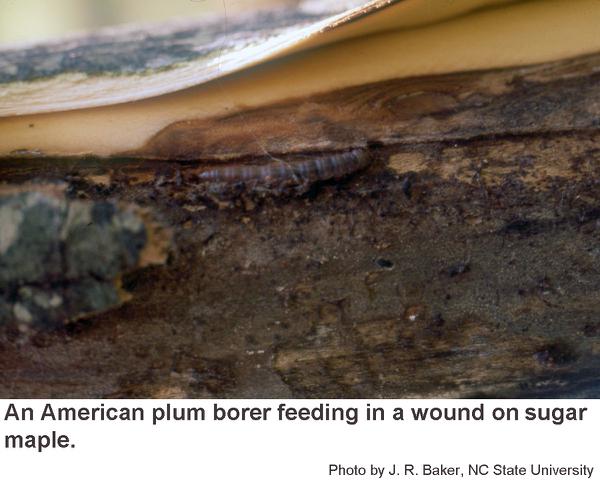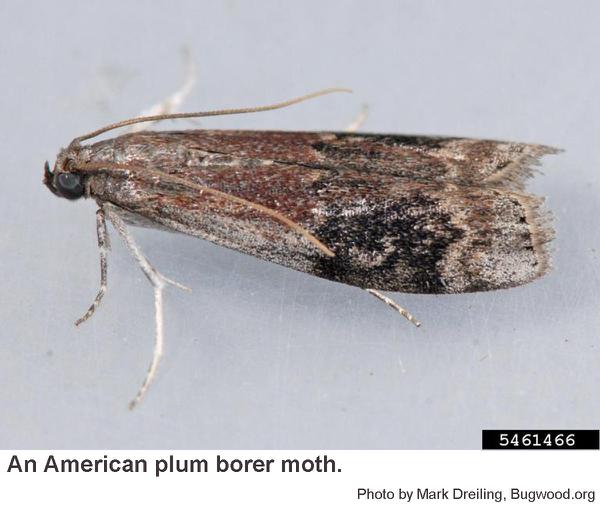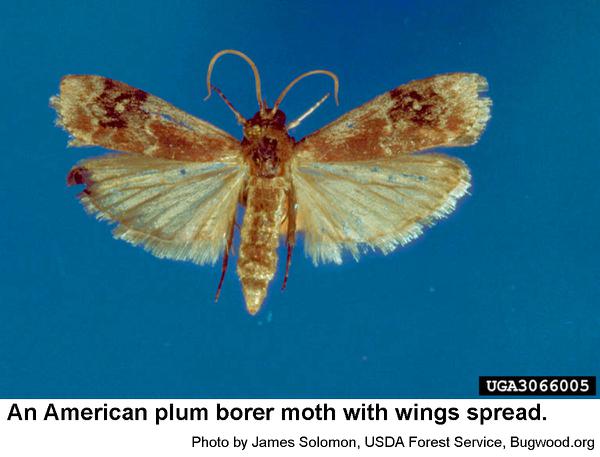Description and Biology
The American plum borer, Euzophera semifuneralis, damages trees by feeding between the outer bark and sapwood much like the dogwood borer does to dogwood. The larval galleries are filled with frass (a dark, granular waste material). The caterpillars bore holes to the outside through which frass is expelled and through which sap sometimes oozes. With young trees, early season infestations can be detected by the wet spots on the bark where sap oozes from the cambium in response to feeding. These borers overwinter as caterpillars in white cocoons under the bark. In April, they mature into small, grayish- to reddish-brown moths that have two dark spots near the tip. These spots may be large enough to form a dark band across the wings. The moths fly at night, mate and lay eggs for a new generation. Females lay tiny pink to white eggs on bark, and after hatching, tiny new caterpillars crawl about looking for a way to bore under the bark. American plum borers are greenish to pink to almost purple caterpillars that grow to about an inch long. The head is dark brown. These borers often attack wounds, cankers or rough spots in the bark. Mature caterpillars spin a white cocoon inside of which they molt into a fusiform, brown pupa about half an inch long.
Host Plants
The American plum borer, is a sporadic pest of ornamental plums, cherries and maples and has been called a "minor" pest of peaches and apples in North Carolina. It also infests the black knot fungus galls on wild cherry as well as galls of a wide range of other hardwoods, especially in the rose family and walnut family. Extensive boring by the caterpillars can ruin fungus galls that would otherwise be used by wood turners to turn bowls and other objects.
Residential Recommendations
At least two kinds of wasps parasitize the American plum borer and woodpeckers and other predators also help to moderate the population. One method of treating the borers inside a tree is to inject the tree with an aromatic solvent such as finger nail polish remover using something such as a oil can as an injector. As long as the solvent is not a registered pesticide, this is legal. Specimen trees can be protected by spraying with a pyrethroid insecticide in May and August. When used as directed, pyrethroids are very toxic to insects but are not particularly hazardous to humans and pets (other than fish-avoid using pyrethroids around pools, ponds, and streams). These insecticides are available in the garden sections of most big box stores as well as nurseries and garden center.
References
- American Plum Borer, Euzophera semifuneralis (Walker). Anonymous. No Date. Virginia Tech.
- American Plum Borer. Krawczyk, G. 2017. Tree Fruit Production, PennState Extension.
- NC State Extension Plant Pathology Publications
- NC State Extension Horticultural Science Publications
- North Carolina Agricultural Chemicals Manual
For assistance with a specific problem, contact your local N.C. Cooperative Extension center.
This Factsheet has not been peer reviewed.
Publication date: Aug. 24, 2017
Reviewed/Revised: Aug. 29, 2019
Recommendations for the use of agricultural chemicals are included in this publication as a convenience to the reader. The use of brand names and any mention or listing of commercial products or services in this publication does not imply endorsement by NC State University or N.C. A&T State University nor discrimination against similar products or services not mentioned. Individuals who use agricultural chemicals are responsible for ensuring that the intended use complies with current regulations and conforms to the product label. Be sure to obtain current information about usage regulations and examine a current product label before applying any chemical. For assistance, contact your local N.C. Cooperative Extension county center.
N.C. Cooperative Extension prohibits discrimination and harassment regardless of age, color, disability, family and marital status, gender identity, national origin, political beliefs, race, religion, sex (including pregnancy), sexual orientation and veteran status.



